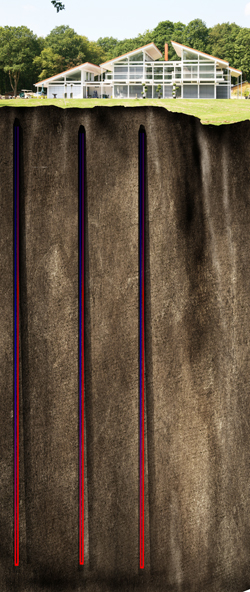 Where there is not enough land to install a horizontal ground array, bore holes can be drilled vertically into the ground to collect heat for the ground source heat pump.
Where there is not enough land to install a horizontal ground array, bore holes can be drilled vertically into the ground to collect heat for the ground source heat pump.
Normally a set of boreholes is drilled to a depth of about 100m and should be set apart by at least seven meters. A geothermal probe consisting of two pipes with a U-bend at the bottom is inserted into the hole. The hole is filled with a special geothermal grout designed to ensure a good thermal contact between the inserted probe and the ground. The probes in each borehole are routed back to a manifold, where they are connected together in just the same way as they are in a horizontal ground loop system.
When the drilling is complete, the boreholes are flushed with clean water, tested to ensure that they flow freely, and are filled with a mixture of water and glycol to form an anti-freeze liquid that is the heat-transfer fluid used in the system.
While boreholes are considerably more expensive to install than a corresponding horizontal ground loop system, they do benefit from the more consistent higher temperatures the deeper into the ground you go. Generally this means that the ground temperature is 2-5°C higher than horizontal ground loops installed at one metre deep. This equates to needing less pipe to extract the same amount of heat and increased seasonal performance of the ground source heat pump of up to 20%.
Whilst this may not always compensate for the additional cost of installation, it does mean that boreholes can be installed in more compact sites with less available land and also have a dramatically reduced impact on any reinstatement of the landscape.






